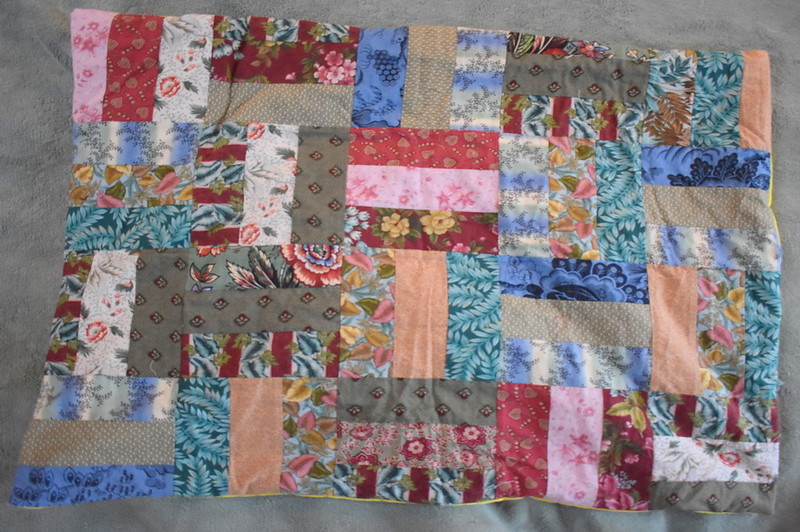What is a fidget blanket, and how do you use it? Fidget blankets or sensory blankets have become popular over the past few years for seniors affected with dementia or Alzheimer’s disease. These individuals have restless hands that can benefit from something that they can focus on.
Fidget blankets will allow these individuals to redirect their energies into something familiar while being in the comfort of their own homes. Sensory blankets can be made by repurposing old materials from around the house, and they are pretty easy to make. Learn how using the tips below.

How To Make A Fidget Blanket
Step 1: Select the materials to use
Among the most important parts of creating a fidget blanket include choosing the suitable materials to use, materials that are durable and machine-washable. You can use two types of fabrics: a soft one like fleece to go on the lap and a textured one for embellishments.
Don’t limit yourself to picking types of materials. Fidget blankets can be quilted, knitted, or crocheted to provide textures or sensory stimulation for those living with dementia.
Step 2: Sew the fabrics together
Cut out your fabrics into the size desired. Sew the reverse sides of the fabrics together, leaving a three-inch opening for turning.
After turning the blanket, secure the rest of the blanket by sewing the opening shut. You can cut different types of fabric in equal-sized squares for a quilt-type option with different fabrics and textures.
Place the squares together, ensuring that the ends match each other, and sew the backside of quilt pieces. Attach pins to hold the fabrics in place while they are being sewn together. Leave a three-inch unsewn opening for turning.
Step 3: Decide on the embellishments to add
After turning your blanket, you can begin personalizing the blanket. In selecting embellishments, it is ideal to take into account what the receiver would need.
For instance, if he or she constantly pulls on their jacket zipper, you can add a zipper to the fidget blanket as well. There is no limit to your imagination — some fidget blankets feature buttons, ribbons, beads, ropes, toggles, and shoelaces, to name a few.
You can also personalize the blanket by adding the receiver’s name to the blanket, or adding items related to things they enjoy. Make sure that all the items on the fidget blanket are correctly reinforced. This is to avoid patients pulling on them or putting them in their mouth, which could turn them into choking hazards.
Who Benefits From Fidget Blankets
Individuals living with dementia or Alzheimer’s
When dementia or Alzheimer’s enter the later stages of the disease, the brain no longer works properly to stay calm. Those living with these diseases may start pulling on their clothes or scratch themselves. Fidget blankets become their outlet for their restlessness and aggression, as it gives them something to do.
Individuals with autism
People living with autism are likely to become overloaded with sensory inputs. They may tap their fingers or pull at their clothes. A fidget blanket can keep their hands occupied to help them focus, especially during therapy sessions.
Individuals with congenital disabilities or traumatic brain injuries
Making a busy blanket for someone suffering from a brain injury can help relieve stress or agitation. Incorporating the patient’s favorite items on the blanket can help stimulate memories and improve his or her brain activity.
Benefits Of Fidget Blankets
Encourages development of motor skills
Seniors who have dementia or Alzheimer’s who have restless hands use fidget blankets to use their hands and alleviate agitation, as it gives them something to focus on. This allows their energy to be redirected into something familiar to them.
Includes mindful activities
Children and adults alike learn best when they engage their senses. This is why providing sensory stimulus is crucial to brain development. Using fidget blankets can improve a person’s ability to learn more tasks and gross motor skills.
Calms or relieves anxiety
Fidget blankets are proven to reduce anxiety and relieve restlessness as they help make the nervous hands of patients busy. By including items on the blanket that could mean something to the patient, the blankets can stimulate the brain through memories and senses, leaving the patients with a sense of security.
Fidget blankets offer a lot of comfort for individuals living with dementia or Alzheimer’s. It provides them with sensory and tactile stimulation and can even relieve them of anxiety.
When a disease such as dementia progresses, a person’s hands tend to get more nervous and fidgety; thus, they need these blankets to stimulate their memories and senses. While these are made with seniors in mind, fidget blankets can be used for other patients as a therapeutic sensory play item.
These blankets can be customized with patterns, textures, ribbons, beads, zippers, pompoms, pockets, and other personal items. No matter what you include in your fidget blanket, ensure that all items are attached securely to avoid patients from pulling them out. The decorative items should also be large enough to prevent them from being a choking hazard.
Conclusion
If you or a loved one are having trouble in dealing with nerves at certain times, learning what is a fidget blanket may help you out. This is a helpful tool in calming yourself down whenever necessary. Instead of seeking professional help right away, try the efficiency of fidget blankets first.
